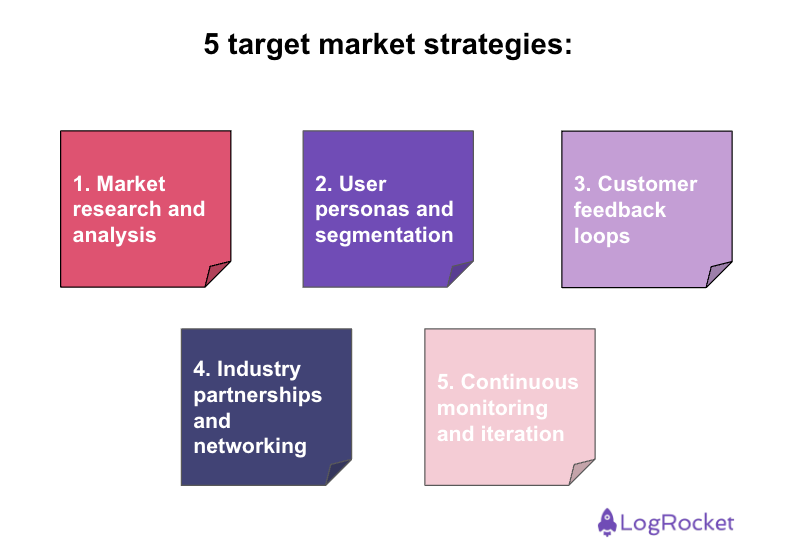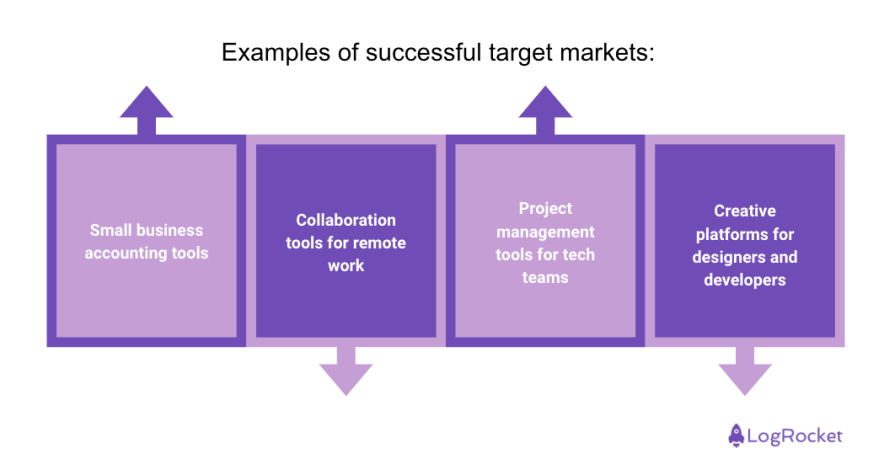Imagine that you’re creating a series of artistic iPhone cases — sparkly unicorns, football mayhem, calming countryside, etc. — but you’re creating these great products for an audience that doesn’t own iPhones. Instead, they predominantly use Android phones that have different phone specifications. This creates a situation that’s like playing darts blindfolded.

You can build the most innovative products, but if you don’t identify the right target audience, you’re not going to generate any revenue.
What is a target market? How do you know it’s the right target market for your business? How can you make target markets a key element of your overall marketing strategy? Let’s find out…
A target market is like finding the perfect pair of shoes in a sea of options. As a business, you want to find the specific set of consumers that will buy, use, and appreciate your products and services. A lot hinges on understanding who your potential customers are, what they need, what their pain points and behavior patterns are, and where to find them.
Finding the right target market is important to know who you are building for and what you should be building for them. You don’t want to end up creating snow boots for desert nomads or lace-tying shoes for flip flop beach goers.
Identifying the right target market and understanding it well will set your business up for success, allowing you to customize your product development and marketing efforts to meet the needs of potential paying customers. Whether it’s designing user-friendly products, crafting compelling ads, or engaging on social media, you should aim to resonate and create deep connections with your target audience.
By honing in on a specific target market, you can avoid the scattergun approach and hit the bullseye with your marketing efforts, leading to happier customers, increased sales, and a stronger brand presence in the competitive marketplace.
By understanding the different types of target markets, you can customize your business offerings to specific user requirements, develop more effective marketing strategies, and better position yourself in the competitive marketplace. Target markets can vary widely depending on factors such as the type of product/service, user personas, specific customer pain points, and more. Here are some types of target markets:
Identifying, understanding, and honing your target market requires a combination of customer feedback, market research, and data analysis. This is important because it will lead to higher customer satisfaction and more focused marketing efforts, ultimately leading to sustainable business growth. Here are five approaches you can use to identify your target market:

By deeply understanding your potential target audience through market research, including demographics, psychographics, behaviors, and needs, you can effectively identify gaps and opportunities. This also includes analyzing industry trends, competitor offerings, and the dynamic economic conditions of the market. This will give you product direction and help you build a solid vision for your business.
Based on what you learn by doing market research and analysis, you can develop detailed user personas that represent your ideal customer base, including demographics, job roles, interests, and goals. You can also segment your potential target audience into different groups, especially if you have different product/service offerings. This will help you build stronger connections with your target audience.
Enable your potential customers to try out your product prototypes or early versions of the product and give their feedback on usability, functionality, and the overall user experience. This iterative approach of refining products, based on customer feedback and beta testing, will help you build the right products and also foster a sense of trust and loyalty among early adopters and brand advocates.
You can build credibility in the marketplace by partnering with other established brands in the market that complement your own brand and/or product offerings. By participating in industry events, conferences, and workshops, you’ll find valuable networking opportunities to meet potential customers and gain industry insights into what’s working and what’s not.
The needs of customers are always evolving and the market is highly competitive. To stay relevant and gain competitive advantage, you need to continuously monitor user, market, and industry trends and iterate your product development and marketing efforts accordingly. Identify key performance indicators that will help you measure customer engagement and satisfaction.
An effective target market strategy is crucial to the success of your business, as it can help your teams become more efficient with less resources. Developing a target market strategy involves a systematic approach that combines market research, data analysis, and strategic decision making. Here’s a step-by-step guide to help you develop your target market strategy:
Target market segmentation is when you identify distinct groups of users with shared characteristics and needs that’ll use your products/services in specific ways. Market segmentation enables you to divide your potential customer base into manageable chunks. This helps in customizing product and service offerings that fit with users’ needs and craft compelling marketing campaigns that establish strong emotional connections with them, leveraging each segment for maximum revenue impact.
For example, Adobe’s Creative Cloud provides different products to different market segments, based on whether they are graphic designers, video creators, or photographers.
Target market segmentation isn’t about dividing customers into neat little boxes, it’s about uncovering those hidden gems and untapped opportunities. Take Slack, for example — the company initially targeted tech startups and smaller teams. It soon realized that there was a growing demand for their collaboration platform among larger enterprises.
By segmenting its target market beyond its initial customer base, Slack was able to provide value with its product offerings to Fortune 500 companies and government agencies. The company now offers different packages with different features and pricing, based on the market segments it serves.
Many software companies have been able to grow sustainably by successfully identifying and leveraging the right target audiences. These companies were able to build loyal customer bases and also gained a competitive edge in a highly dynamic market. Let’s look at some of these companies and the accompanying target markets:

Intuit’s QuickBooks and Xero offer accounting software, specifically targeted to small businesses. These platforms provide simplified bookkeeping and accounting processes, with user friendly interfaces and customized features to meet the needs of small business owners, who might not have the resources and lack the accounting expertise themselves to keep the business running.
With the rise of remote work, collaboration software such as Slack, Zoom, Google Workspace, etc. have become essential for businesses and individuals alike. By specifically targeting remote workers and freelancers, these platforms provide real-time communication and collaboration, the ability to video chat and share files, and seamless integration across different devices.
Software tools like Atlassian’s JIRA, Trello, Asana, and Wrike have captured the project management market, specifically targeting tech teams around the world. These platforms offer agile project management features, integrations with developer tools, and customizable process workflows, thus catering to the unique requirements of software development projects.
Software such as Adobe and Pixlr target creative professionals who need powerful and accessible tools for photo/video editing and graphic design. These cloud-based platforms provide large storage for heavy media files, advanced features, and user friendly interfaces. Whether you’re a corporate designer or a social media influencer, you can leverage these tools from any device, even when you’re on the go.
Defining your target market is pivotal for success. Through strategic approaches like market segmentation, customer research, and competitive analysis, you can unlock valuable insights into the needs and preferences of potential users. While there are various types of target markets, you need to pick the ones that offer the highest growth potential for your product/service offerings.
To remain relevant and for sustained growth, you need to continuously monitor and refine your target market strategy. Here are three key takeaways:
Embrace your target market strategy, leverage the power of data-driven insights, and tailor your approach to captivate potential customers in the dynamic realm of product innovation. Now, when you’re creating those beautiful phone cases, you’ll know exactly who you’re selling them to!
Featured image source: IconScout

LogRocket identifies friction points in the user experience so you can make informed decisions about product and design changes that must happen to hit your goals.
With LogRocket, you can understand the scope of the issues affecting your product and prioritize the changes that need to be made. LogRocket simplifies workflows by allowing Engineering, Product, UX, and Design teams to work from the same data as you, eliminating any confusion about what needs to be done.
Get your teams on the same page — try LogRocket today.

Most teams fail at autonomy. Learn how clear rules help product teams move faster without micromanagement.

A practical framework for PMs to use AI in ideation without sacrificing judgment, strategy, or decision quality.

A practical five minute revenue estimation method to help product managers compare ideas, drop low impact features, and prioritize smarter.

A practical guide for PMs who want to stop being bottlenecks, delegate smarter, and lead teams effectively with a clear ownership framework.